The word “Victorian” has many connotations. From industrialism to Gothic Revival to eccentric, begoggled oddballs inventing things like air-conditioned top hats and spectacles for short-sighted horses, the long reign of Queen Victoria encompassed a heady mix of the sublime, the ingenious and the downright insane. Naturally, this makes for some rather interesting interior design. Especially where bathrooms are concerned!
Embodying the very best of the regal elegance and outlandish indulgence of 19th century Britain, Victorian-inspired bathrooms are a popular choice for more traditionally minded consumers with a flair for bold, individual expression. If you’re looking to create your very own Victorian bathroom sanctuary, we’ve compiled all the information you could possibly need in one handy guide. Let’s get cracking, shall we?
When Was The Victorian Era?
The Victorian era refers to the years between Queen Victoria’s ascension to the throne in 1837 to her death in 1901, covering all the cultural trends, societal changes, and technological advances that occurred within. It represented the apex of the British Empire, which spanned the globe and brought great wealth and prosperity to the upper classes. The Victorian age saw the birth of everything from association football to the modern Labour Party, with a diverse explosion of art, music, literature drawn from every corner of the world.
Unsurprisingly, this tasty multicultural soup stirred up some pretty funky aesthetics, which we shall now begin to explore. Gentlemen, wax your sideburns and straighten your tailcoats. Ladies, tighten your corsets and hold onto your comically oversized dresses; we’re going in.
What is Victorian style?
Distilling the entire aesthetic evolution of a sixty-year period down to a few short paragraphs is an impossible and, quite frankly, silly endeavour. Still, let’s do it anyway.

https://www.pinterest.co.uk/pin/27795722689498278/
Essentially, Victorian-inspired bathrooms can be summed up in three handy words: opulent, decorative and celebratory. After all, things were pretty peachy for the upper crust back then. While the lower classes didn’t really have time to concern themselves with anything beyond not being dead, the more well-to-do sorts had an abundance of wealth, power and free time to muck about with. This, combined with the wild mix of influences from across the world, resulted in intricate patterns, bold colours and an eclectic mishmash of styles.
So, What Does This Mean For Your Bathroom?
We’ll delve more deeply into the specifics later, but a Victorian bathroom must properly reflect the era it’s drawing from. In terms of décor, this means rich, deep colours – think bold purples, blues and greens adoring the walls and floor, as well as gorgeously patterned tiles. Bright porcelain and enamel are preferred for basins and toilets. Taps should be finished in gleaming metallic hues and capped off with classical crosshead handles.
The crowning feature of any Victorian bathroom is, of course, the bath itself. Often placed in the centre of the space as an eye-catching focal point, the bath should be as broad and sweeping as your interior can accommodate. A slipper bath is the archetypal Victorian stalwart, but any traditional freestanding bath can work just as well.
Other Victorian flourishes include decorative mirrors, eccentric ornaments and fresh potted plants, as well as strikingly crafted traditional vanity units. Sumptuous metallic accents such as chrome, brushed brass and gold are definitely period appropriate, especially when it comes to showers. A riser rail with an exposed valve will fit the theme perfectly, compete with a gorgeous traditional shower head or handset.
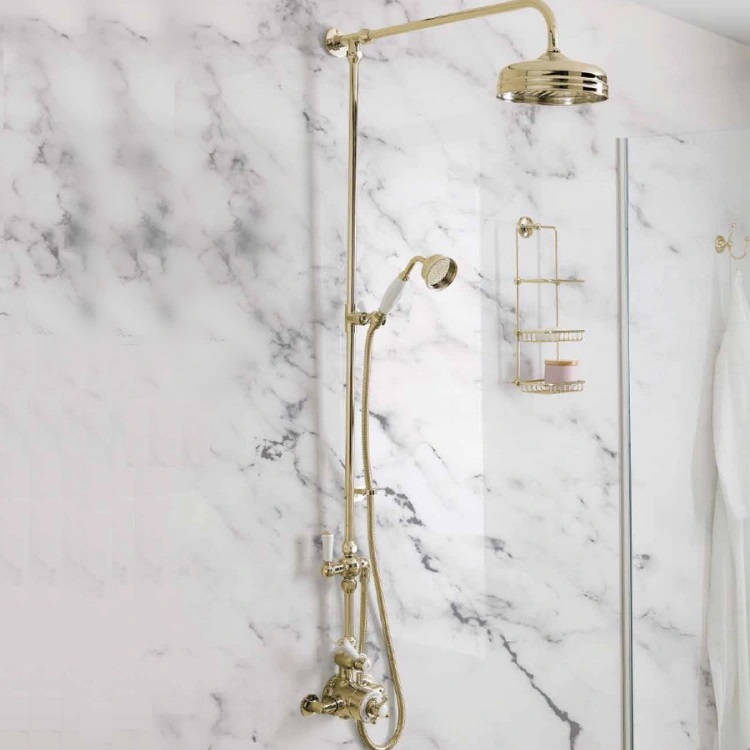
How Does Victorian Style Differ From Other Time Periods?
An important question to consider. Victorian bathrooms are actually surprisingly specific, with several features that aren’t found in other period-inspired designs. People tend to lump everything ‘traditional’ into the same boat and call it a day, but there are subtle differences between Georgian, Victorian and Edwardian (aka ‘The Big Three’) that you need to be aware of if you’re going to do this right.
A good way to look at it is to see Victorian as the slightly weird middle child between the more subdued Georgian and Edwardian eras. They do share many similarities, such as high-cistern toilets, square basins and handsome freestanding baths, but the overall style and feel are quite different in several key ways.
vs Georgian Bathrooms
The Georgians didn’t actually have dedicated bathrooms, so Georgian designs tend to take their cues from the ‘dolls house’ country mansions of the day. Think delicate sash windows, airy, spacious interiors and light, muted colours. Black-and-white tiled floors are common, with repeating patterns like trefoils and simple marble another era-accurate flourish. Metallic boat baths and console sinks are a must, while decorative chairs, rugs and other antique furnishings all contribute to the overall Georgian aesthetic.
The general feel was one of simple, restrained elegance, which gradually evolved over the decades into the more bombastic, eclectic tastes of the Victorians.
vs Edwardian Bathrooms
Edwardian bathrooms, meanwhile, represented a big shift back into the opposite direction. Compared to the frantic upheaval of the 19th century and the looming carnage of World War I, the brief decade of Edwardian rule was actually pretty chilled out. Edwardian-inspired bathrooms tend to reflect this, emphasising simple tranquillity and recognisable hints of modern minimalism.
The fixtures and fittings of Edwardian bathrooms tend to employ basic geometric shapes, scaling back quite significantly on the ornate flourishes of Victorian interiors. The colours are usually muted pastels that are still used in contemporary bathroom design, such as lilac, primrose yellow, eau-de-nil, soft grey and duck egg. Basic floral patterns are often found on tiling and feature walls, while quietly elegant mirrors, accessories and furniture will all contribute to the feel of functional, traditional unfussiness.
Did Victorians Actually Have Bathrooms? How Did The Victorians Inspire The Modern Bathroom?
As mentioned above, the concept of the bathroom as a separate space didn’t really exist until the Victorian age. Even in Georgian times, relieving yourself simply involved braving the elements for a quick trip to the outhouse (or even just the outside). Chamber pots and bedpans offered indoor alternatives, but these weren’t the most fragrant or indeed hygienic of solutions (particularly for the servants who had to clean them out).

https://www.pinterest.co.uk/pin/742319951100235935
Bathing itself usually just happened in the bedroom. It consisted of a quick scrub of the face, armpits and unmentionables with whatever cold, less-than-sanitary water you could scrounge up. Actual baths were infrequent and generally reserved for the rich, and even these just took place in the bedchamber as opposed to any specialised room.
So, What Changed?
The advent of the dedicated bathroom occurred deep into the Victorian age, assisted greatly by the introduction of sewer systems and indoor hot water piping. Bathrooms began to appear commonly in the homes of the wealthy in the 1880s, and were originally just existing rooms retrofitted for the purpose. At first, they were simply decked out with the same wooden furnishings and panelling as other rooms. However, this quickly transitioned into porcelain or linoleum tiling when it became apparent that wood and hot water pipes didn’t play nicely together. With this final development, the prototype of the contemporary bathroom was born.

https://www.pinterest.co.uk/pin/271412315033557027
The phrase ‘bathroom’ was coined because Victorian homes tended to have their bathtub and basin one room, with the toilet banished to a separate room known as the water closet or lavatory. These gradually condensed down into the all-purpose bathrooms we know today, although many contemporary homes do still feature a separate WC in addition to their main bathroom.
Speaking of which, we can’t discuss Victorian influences on modern bathrooms without examining…
The Invention of the Flushing Toilet
All right, so the Victorians didn’t actually invent the flushing toilet, but they certainly made it what it is today. Various contraptions based around the removal of human waste with running water had been proposed for thousands of years, but they often found themselves thwarted by a single fiendish adversary: the smell. This all changed in 1775, when Scottish inventor Alexander Cumming became the first person to patent a fully functional, odour-proof flushing toilet. His design was based around an almost laughably simple tweak – he bent the pipe!

Previous flushing toilets, such as Sir John Harrington’s 16th century attempt, used a straight pipe to dispose of the waste. Cumming’s invention of the S-bend changed all this. Now, instead of a direct line between the toilet and the sewer, there was a curved pipe that allowed water to pool inside, acting as a seal to keep all the nasty gasses down where they belonged. The modern toilet had finally arrived.
Still, despite this game-changing breakthrough, it wasn’t until the middle of the Victorian era when flushing toilets really took off. This was largely due to a notorious event that came to be known as…
The Great Stink
The Industrial Revolution had seen town and city populations swell exponentially throughout the 19th century. Unfortunately, sanitation efforts hadn’t kept up. What meagre toilet facilities there were often found themselves shared by over 100 people. This, combined with a woefully inadequate sewer system, saw cities overwhelmed with countless gallons of human and animal refuse. Cess pits overflowed, rivers were polluted, and streets were submerged in rancid filth. Disease ran rampant as drinking water became inseparable from raw sewage, culminating in devastating outbreaks of typhoid and cholera.
Things came to head during the sweltering summer of 1858, by which time the Thames had essentially been transformed into a huge open sewer pipe. The incredible stench blanketed the city of London, and was quickly dubbed the ‘Great Stink’. Something had to be done, and a bill authorising a complete overhaul of the city’s sewer systems was rushed through parliament that year. With a proper sanitation network finally in place by 1866, the age of the flushing toilet had dawned.

https://www.pinterest.co.uk/pin/334110866111987924
Over the next few decades, Canny plumbers like Thomas Crapper (seriously) would refine the design of Alexander Cumming, creating highly effective flushing toilets that could be mass produced for widespread use. Public toilets were constructed everywhere, costing just a penny to use (hence the polite euphemism, ‘spend a penny’). Flushing toilets soon became popular in wealthier private homes, sowing the seeds for their universal prevalence today.
What Was Victorian Bathing Like? How Often Did They Do It?
The Victorians might have invented bathrooms, but how did they actually use them? Quite sparingly, as it happens. Full-submersion baths considered more of a therapeutic indulgence than a hygienic necessity. Proper baths were usually only taken once every few weeks. Like in Georgian times, day-to-day washing was performed with a sponge and basin of cool water mixed with vinegar.

https://www.pinterest.co.uk/pin/159244536795882315
Working-class people took baths too, despite their lack of actual bathrooms. These would have occurred in the kitchen, as this was always the warmest room in the house. Water was heated on the stove and poured into the ‘bath’, which was usually just a cheap metal tub. The entire household would share the water, taking turns in the increasingly cold and dirty human soup until everyone had been seen to. Better still, the old bath water would then be used to do the laundry!
What Did People Do Between Baths?
A quick sponge bath can only go so far, which meant that Victorians of all classes had to be creative in how they dealt with body odour. Men would douse themselves in a saucy scent called ‘bay rum’ to mask their betwixt-bath musk. This was a heady blend of citrus, spices and rum that originated with 16th century sailors. Women too would absolutely drench themselves in perfume, provided they could afford it. ‘Ambergris’ was a popular choice, which was a charming aroma created from gunk found in the intestines of dead sperm whales.

https://www.pinterest.co.uk/pin/159244536795882315
Of course, ghoulish potions crafted from the faecal matter of butchered marine mammals weren’t in everyone’s price range (for which they were probably quite grateful). Many women used cheap scented powders to mask unwanted smells, which had the added bonus of absorbing sweat. Ladies could also wear ‘dress shields’, which were special inserts fitted beneath dresses to protect them from underarm sweat marks. It was important to keep dresses as clean as possible, as they were often so delicate that they couldn’t even be washed without risking damage.
How Did The Victorians Look After Their Hair and Teeth?
Luckily for men, short hair was in vogue for the duration of the Victorian period. This meant they didn’t have to worry too much about washing their barnets. On the flip side, women’s hairstyles became so intricate and complicated that they took forever to arrange. Doing their hair became such a bother that they rarely removed the pins and let it all hang loose (usually just for special private time with their husbands). Thus, they too didn’t wash their hair very often, usually only doing so every two to four weeks.

https://www.pinterest.co.uk/pin/213991419784941799
This was actually a blessing, as prevailing wisdom prescribed that women’s hair should be washed with a lethal mixture of ammonia diluted with water. This was obviously highly corrosive, and certainly succeeded in blasting away the oil and dirt (as well as a nice chunk of scalp).
Another option was onion juice, which are two words that should never, ever be put together for any reason. Onion juice (blegh) was supposed to help the hair grow long and lustrous, which was presumably worth the cost of smelling like an overripe shallot for the next fortnight. Then again, if you’re habitually soaking yourself in bottled whale excrement, what’s a little splash of onion going to hurt?

https://www.pinterest.co.uk/pin/5770305757400918
As for tooth care, the Victorian age did actually bear witness to the invention of the toothbrush in 1857. However, this novel creation didn’t really catch on until the 1930s with the addition of nylon bristles. Most Victorians simply sprinkled salt on their fingers and giving their gnashers a quick rub. Not surprising, considering the fact that 19th century dentistry mainly consisted of pulling teeth and chugging opium.
How Do You Decorate Your Bathroom in a Victorian Style?
Now that we’ve enjoyed an eventful jaunt through the weird, wonderful and frankly dangerous world of Victorian bathing, let’s take a closer look how you can transform your own bathroom into a stunning bastion of period-inspired beauty.
Is My Home Suitable For A Victorian Bathroom?
Absolutely! While most Victorian-style bathrooms tend to be found in older houses with a wider period theme, there’s nothing stopping anyone with a modern home from crafting their own dream Victorian bathroom. In fact, this actually fits rather well with the Victorian concept of ‘orderliness and ornamentation’. This meant that every room in the house had its own distinctive décor, reflecting its owner’s unique, multifaceted personality.
Like any other renovation project, you simply need to keep in mind your budget, plumbing setup and spatial dimensions when figuring everything out. Victorian-inspired décor, fixtures, sanitaryware and accessories are available in any price range nowadays, so it’s simply a matter of planning and imagination.
Choosing The Décor
Firstly, you need to choose your colour scheme and tiling. The Victorians liked things rich, colourful and bursting with individual flair, which means you can go as hard as you like in terms of the general décor. Ornate tiles are always a winner, either spread across the whole bathroom or concentrated into a single feature wall to break up a white-heavy space. If you’re going for the latter, you should choose the biggest wall that catches the most light in order to really help it pop.
Tiles can be used on the wall, the floor or even both, with a wealth of different styles available. You can go for an intricate floral mural spread across multiple tiles, or go for patterned tiles in diverse variants such as Indian, Moroccan or mosaic. Bold colours like deep reds, purples, blues and greens can be used to craft dazzling displays of alternating shades, which can also be achieved with paint if you’d rather not splash out on a tiler.
Basins
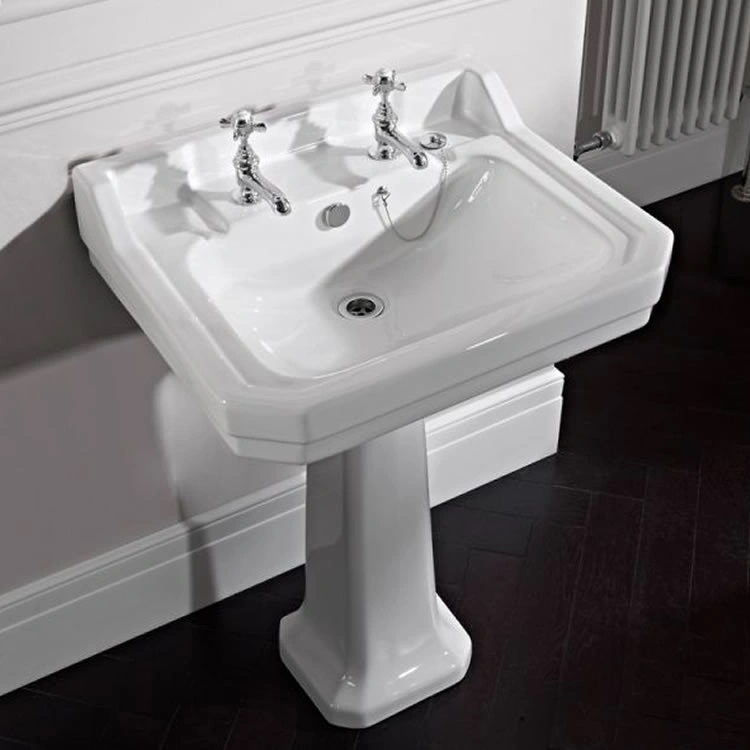
For true authenticity, a traditional pedestal basin is a must-have. Gleaming white porcelain is the material of choice, while the shape should be thick and squared. Decorative ridges will complete the Victorian look, eschewing the smooth, unbroken look of minimalistic modern sinks.
A washstand or console basin can also be used if you don’t like the pedestal look, although this is admittedly slightly more Georgian. Freestanding is more desirable than built in, but you can still go for a wall-mounted /semi-pedestal model if you’re working with a smaller bathroom or cloakroom. If you do select a wall-hung basin, choose a squared traditional model with exposed metallic piping beneath.
Taps

Baths and basins should be adorned with metallic pillar taps, with gold, brass and chrome all fine choices. Depending on your wider theme, the finish can be either sparkling bright or dark and brushed. Crosshead handles were more prevalent than lever handles in the 19th century, complete with decorative ceramic flourishes to accent the metal.
For baths, an alternative to pillar taps is an exposed, deck-mounted bath filler in the two-hole bridged design. Numerous models with attached shower handsets are available, offering additional functionality. If you’re going all out on a freestanding bath, a tall, sweeping floor-mounted bath tap can add some serious period pizzaz.
Toilets
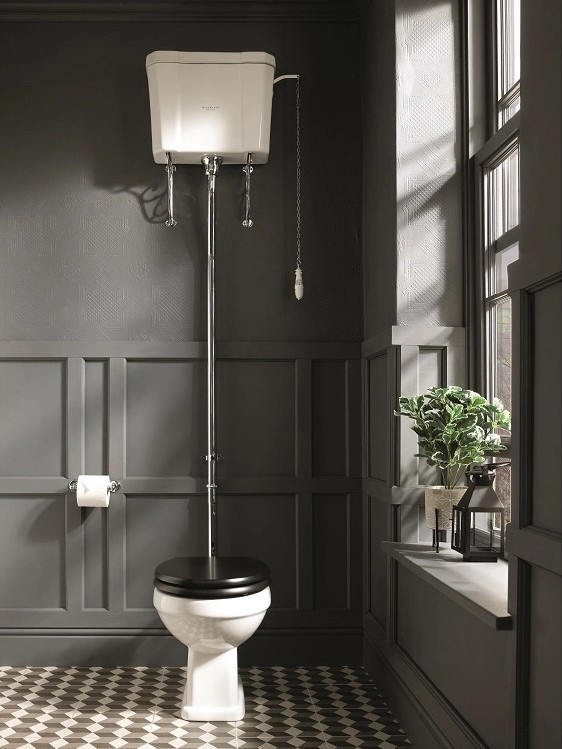
Victorian toilets are notable for their extremely tall cisterns, which were originally born of necessity. The flushing mechanisms weren’t nearly as powerful as they are today, so gravity was required to generate bit of extra oomph. These days, it’s purely a stylistic choice, and you can basically go as tall as your bathroom ceiling will allow. There are countless low, medium and high-level models to choose from, with the latter stretching up as far as two metres!
As for the style, traditional floor-mounted, open-back toilets are much more authentic than wall-hung, back to wall or closed-back toilets. The shape should include a rounded bowl, with a wide, ridged base in a similar style to your basin’s pedestal.
Baths
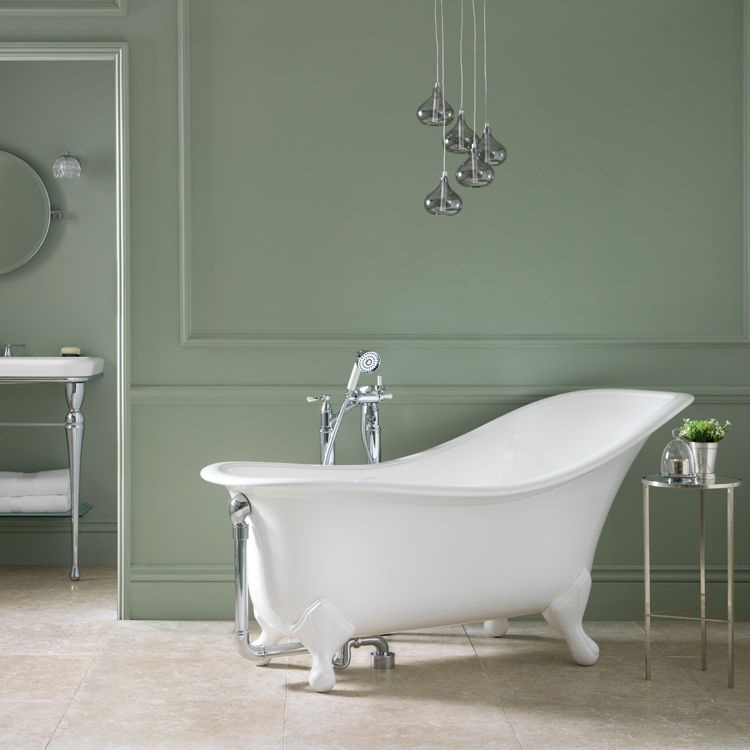
As we said earlier, the bath is the ultimate feature of any proud Victorian bathroom. If your space allows for it, you should definitely choose a freestanding bath over a back-to-wall or drop-in model. While traditional back-to-wall baths are available, a truly accurate Victorian bathroom should feature an opulent freestanding bath as its crowning centrepiece. Cast iron, enamel-coated tubs are the most desirable, but the material is less important than the looks in this particular instance.
The slipper bath is the classic Victorian model, with its distinctive shape an iconic hallmark of the period. However, it’s important to note that slipper baths are single ended only. If you plan to share a romantic dip with a partner (hair down and all), a double-ended roll top boat bath might be a more appropriate choice. Glossy white is the usual colour, but a multitude of bespoke painted finishes can be added to match your bathroom’s scheme. Clawed or slipper-style bath feet will add a final ornate flourish.
Showers
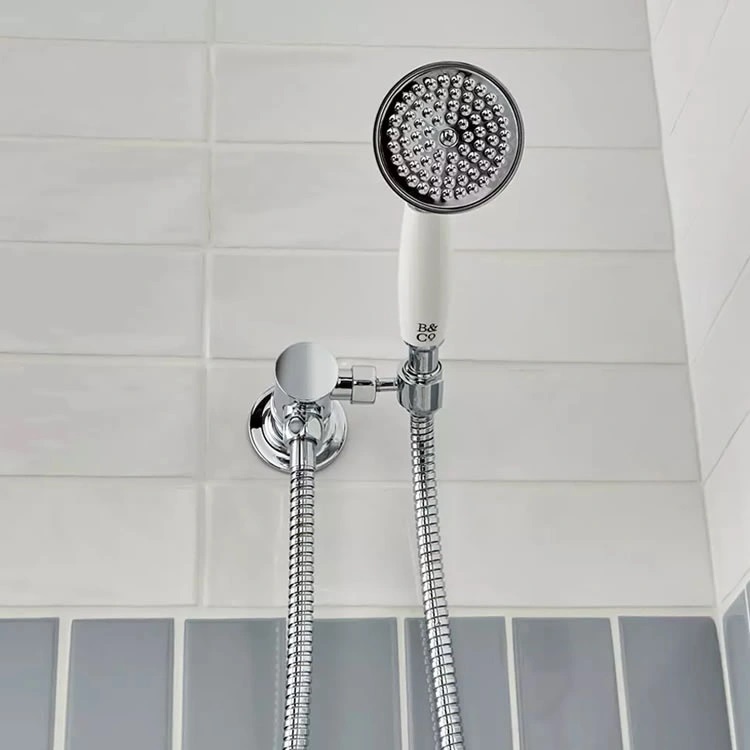
Showers didn’t really take off until the tail end of the 19th century, but they did indeed exist during Victoria’s reign. A Victorian shower should continue the exposed metallic look, with riser rail kits much preferred to wall or ceiling-mounted shower heads. The valve should match the faucets in terms of their metal finish, crosshead handles and white accents. You can use a main shower head fixed atop the riser rail, or go for a hose-attached adjustable handset. If you can’t decide, you can even have both! If this is the case, be sure to choose a double-outlet shower valve with a diverter switch.
Furniture & Radiators
True Victorian bathroom furniture should be intricate and artfully designed. There’s nothing like a gorgeous traditional freestanding vanity unit to really bring the period style home, with carved panelled doors and decorative handles both highly desirable qualities. A wall-hung unit can be used to save space, but freestanding is definitely truer to the era.
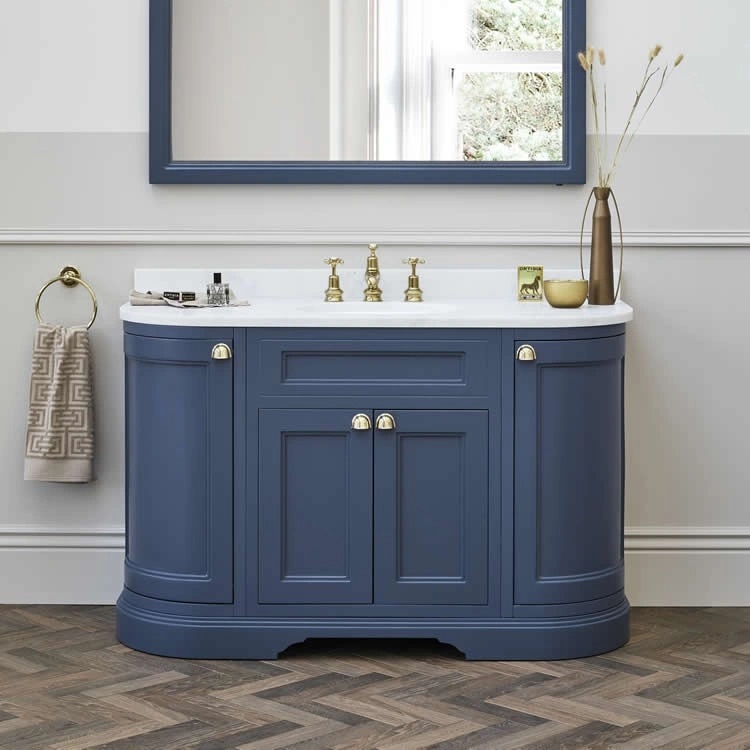
Your vanity unit should fit in with the rest of your décor, either matching the main colour or deliberately contrasting it to create depth and variety. Furniture units can be topped with ornate worktops or inset basins, the latter of which is ideal if you’re lacking space and don’t have room for a separate basin and vanity unit.
No bathroom is complete without heating, and Victorian interiors require suitably Victorian radiators. Again, floor-standing designs, metal rails and visible pipework are the key features here. Thicker rails and pipes will create a more authentic look, while the radiator’s finish should match your brassware and other metallic accents. The radiator’s valves should share the crosshead look of your taps to keep everything nice and consistent.
Ornaments & Accessories
No self-respecting Victorian bathroom is complete without an eclectic mix of ornaments scattered about. It’s all about joyous self-expression, so it’s really up to you what you want to include.
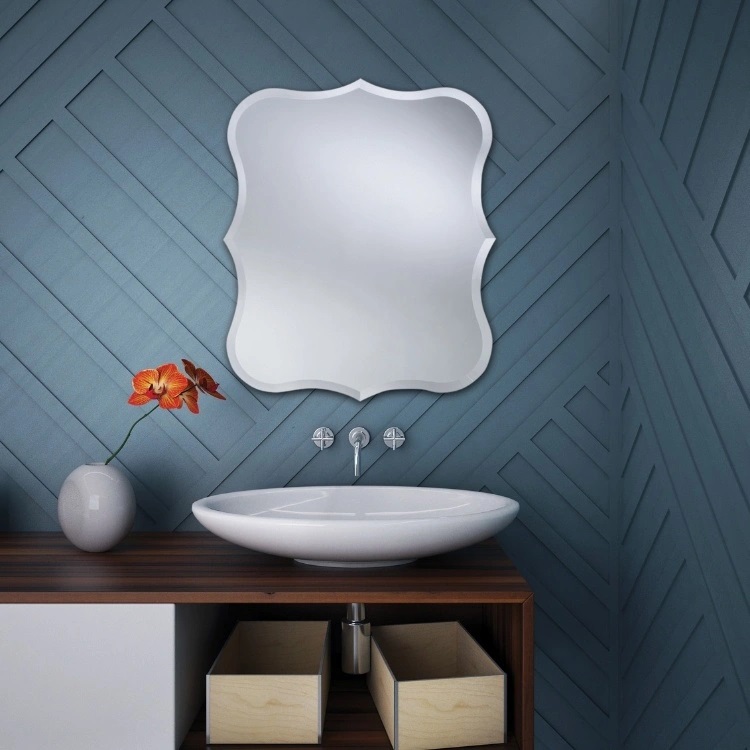
Your ornaments and decorations should reflect your personal interests. Antique chairs, potted plants and decorative mirrors all feel right at home in a Victorian bathroom setting, along with wall paintings and even black-and-white photographs. Antique shops are a great place to pick up fun, eccentric pieces, and quite often on the cheap. You could repurpose decorative glass bottles and jars or head to the beach to forage for seashells, while even little things like décor-matching towels and bathmats can add subtle personal flourish.
As for accessories, you’ll need all the standard bits like shelving, towel rails and robe hooks. There’s a huge range of traditional bathroom accessories out there to suit any period-inspired bathroom, so feel free to browse around and see what jumps out.
Pictures of Victorian-Style Bathrooms
Here we have collated some modern-day takes on Victorian style bathrooms to provide inspiration and ideas for your own space:

https://www.pinterest.co.uk/pin/14777505019432360

https://www.pinterest.co.uk/pin/975240494282459489

https://www.pinterest.co.uk/pin/417849671689583795

https://www.pinterest.co.uk/pin/422281201863009
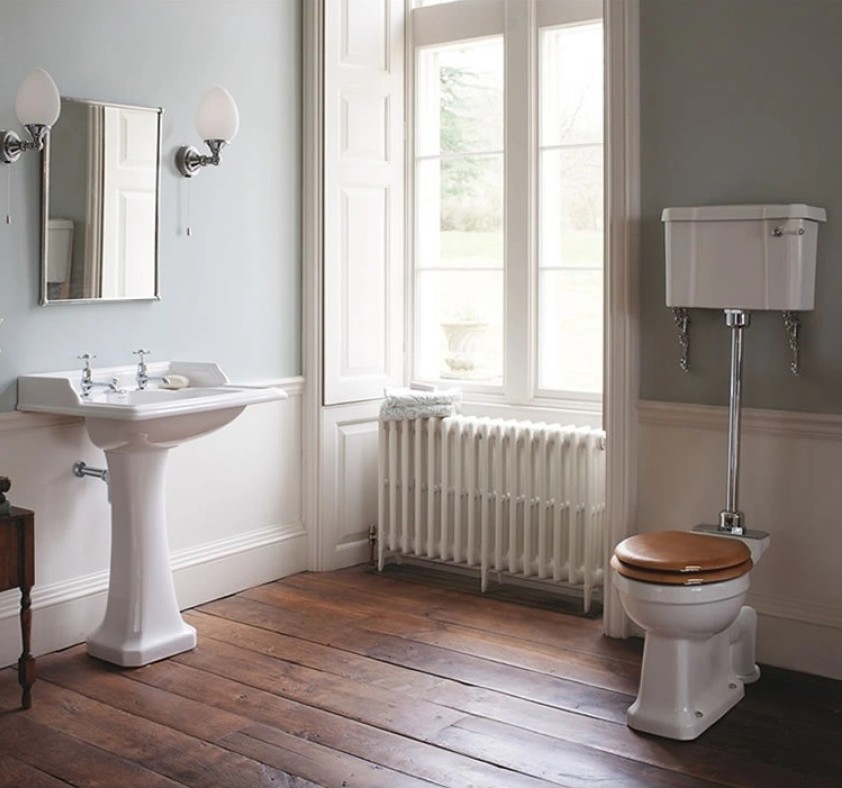
We hope this has been a fun and comprehensive trip through the colourful world of Victorian bathrooms. As you can see, there’s plenty to consider and a lot of choices to make, so by all means get in touch if you’d like some more help.
Our team is always available online or over the phone, and our website is full of fabulous Victorian-style pieces to stir your imagination. Try our 3D bathroom design service for a high-tech preview of how your dream Victorian bathroom will appear once it’s all finished, or pop by our Leeds showroom to look around and chat to us in person. We look forward to hearing from you!


